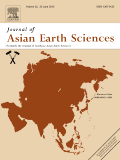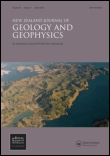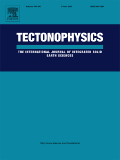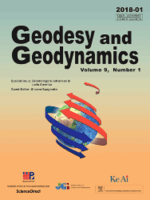
GEOTECTONICS
Scope & Guideline
Unveiling the Dynamics of Our Planet's Tectonic Systems.
Introduction
Aims and Scopes
- Tectonic Dynamics and Geodynamics:
Research focusing on the mechanisms and processes that drive tectonic movements and the resulting geological features. This includes studies on crustal deformation, subduction zones, and plate tectonics. - Seismology and Seismic Hazard Assessment:
Investigations into seismic activity, earthquake prediction, and the assessment of seismic hazards. This includes studies that utilize geophysical data to analyze fault systems and their potential impacts. - Geophysical and Geological Mapping:
Application of geophysical methods, such as seismic tomography and remote sensing, to delineate geological structures and understand subsurface conditions. - Structural Geology:
Analysis of geological structures resulting from tectonic processes, including faulting, folding, and basin formation. This area often incorporates field studies and laboratory experiments. - Geological Resources and Tectonics:
Exploration of the relationship between tectonic settings and natural resources, particularly hydrocarbons and minerals, to assess potential reserves and resource distribution.
Trending and Emerging
- Numerical and Experimental Modeling:
A growing emphasis on numerical modeling techniques to simulate tectonic processes and predict geological outcomes. This trend reflects advancements in computational capabilities and the need for predictive models in understanding tectonic phenomena. - Integration of Remote Sensing and Geophysical Data:
Increased utilization of remote sensing technologies and geophysical data to analyze tectonic and seismic activity. This trend underscores the importance of interdisciplinary approaches in modern geoscience. - Impact of Modern Geodynamics on Natural Hazards:
Research focusing on the implications of current geodynamic processes on natural hazards, particularly earthquakes and their prediction. This is crucial for societal preparedness and risk mitigation. - Tectonics and Climate Interaction:
Emerging studies exploring the interactions between tectonic processes and climate change, particularly how geological processes affect and are affected by climatic conditions. - Geodynamics in Resource Exploration:
A trend towards linking tectonic studies with resource exploration, particularly in hydrocarbon and mineral deposits, reflecting the growing need for sustainable resource management.
Declining or Waning
- Paleomagnetic Studies:
While paleomagnetism has historically been a significant area of research, recent publications indicate a waning interest in this theme, likely due to the emergence of more advanced geodynamic modeling techniques. - Geological History and Stratigraphy:
Studies focusing exclusively on the historical geological record and stratigraphic analysis seem to be decreasing in prominence, possibly as researchers pivot towards more applied aspects of tectonics and resource exploration. - Local Case Studies without Broad Geodynamic Context:
There is a noticeable reduction in the publication of localized case studies that do not connect to broader geodynamic themes or implications, suggesting a shift towards more integrative and global analyses.
Similar Journals

JOURNAL OF ASIAN EARTH SCIENCES
Unveiling the Secrets Beneath Asia's Diverse TerrainJOURNAL OF ASIAN EARTH SCIENCES, published by Pergamon-Elsevier Science Ltd, is a premier international journal dedicated to advancing the understanding of Earth Sciences, particularly within the vibrant and diverse geological landscapes of Asia. With an esteemed Impact Factor reflective of its robust scholarship, the journal is currently categorized in the Q1 quartile for both Earth-Surface Processes and Geology, highlighting its significant contribution to these fields. Researchers can access cutting-edge research spanning geophysical studies, geological formations, and environmental changes via the journal’s Open Access model, ensuring a broad dissemination of knowledge. As the journal converges its focus from 1997 to 2024, it continues to serve as a critical platform for scholars, professionals, and students aiming to explore the unique challenges and opportunities present in Asian Earth sciences. Its commendable rankings of 28th out of 179 in Earth-Surface Processes and 52nd out of 321 in Geology, demonstrate its influence and relevance in the academic community.

Geosphere
Pioneering Research for a Deeper Understanding of GeologyGeosphere is a premier open access journal published by the Geological Society of America, Inc., dedicated to advancing the fields of geology and stratigraphy. Since its inception in 2005, this journal has established itself as a critical platform for sharing high-quality research, evidenced by its robust positioning in the 2023 Scopus rankings, where it holds the 12th rank in stratigraphy and 75th in geology. With an impressive impact factor and a commitment to open access since 2018, Geosphere facilitates the dissemination of significant findings to a global audience, making it an essential resource for researchers, professionals, and students alike. The journal's scope includes a wide range of topics related to Earth and Planetary Sciences, encouraging interdisciplinary collaboration and innovation. Based in the United States, Geosphere continues to foster a community dedicated to understanding the Earth's processes and resources, ensuring that it remains at the forefront of geological research.

NEW ZEALAND JOURNAL OF GEOLOGY AND GEOPHYSICS
Unveiling the Earth's Secrets Through Rigorous Research.NEW ZEALAND JOURNAL OF GEOLOGY AND GEOPHYSICS, published by Taylor & Francis Ltd, stands as a prominent forum dedicated to the interdisciplinary exploration of geological and geophysical phenomena. With an impact factor that situates this journal in the prestigious Q1 category across key subjects—namely Earth and Planetary Sciences, Geology, and Geophysics—it is a critical resource for researchers, professionals, and students alike. The journal has been operational since 1958 and continues to contribute valuable insights into the complexities of the Earth's processes. Although it does not currently offer Open Access options, its broad readership benefits from an extensive archive of high-quality research findings that span from 1958 to 2024. Located in the United Kingdom, the journal remains a pivotal player in advancing the understanding of Earth's systems, making significant contributions to both academic inquiry and practical applications in the field.

TECTONOPHYSICS
Advancing Earth Science through Innovative ResearchTECTONOPHYSICS is a leading journal published by Elsevier that has been at the forefront of earth and planetary sciences since its inception in 1964. With both its print and e-ISSN identifiers (0040-1951 and 1879-3266), the journal offers a reputable platform for disseminating high-quality research in Earth-Surface Processes and Geophysics, proudly positioned in the Q1 category for both fields in 2023. With a Scopus ranking of #43 out of 179 in Earth-Surface Processes and #43 out of 165 in Geophysics, TECTONOPHYSICS demonstrates a strong impact, making it an essential resource for researchers and professionals involved in the geological and geophysical sciences. Published in the Netherlands, TECTONOPHYSICS is committed to advancing knowledge in tectonics and related disciplines, fostering innovative research that impacts our understanding of Earth's dynamic processes. The journal invites contributions that push the boundaries of science, making it a must-read for academia and industry alike.

Solid Earth Sciences
Advancing our understanding of Earth's hidden depths.Solid Earth Sciences is a dynamic open-access journal published by Elsevier, dedicated to advancing our understanding of the Earth's subsurface processes and materials. Since its inception in 2016, the journal has established itself as a vital resource for researchers and professionals in the fields of geochemistry, petrology, geology, geophysics, and geotechnical engineering, achieving a notable Q2 ranking in multiple categories as of 2023. With an ISSN of 2451-912X, the journal aims to disseminate high-quality research that enhances knowledge of earth surface processes and the intricate interactions within our planet's systems. The journal is indexed in Scopus, showcasing an impressive rank in various sub-disciplines, with a rank of #96 in Geology and a noteworthy percentile in Earth and Planetary Sciences. Solid Earth Sciences offers a platform for innovative studies, comprehensive methodologies, and cutting-edge technological advancements that cater to a global audience of scientists, academics, and students. With its commitment to open access, it fosters wider dissemination and impact of research outcomes, ensuring that pivotal discoveries reach stakeholders and contribute to real-world applications.

Geodesy and Geodynamics
Navigating the Landscape of Geodesy and Geodynamics.Geodesy and Geodynamics is a premier open-access journal dedicated to the interdisciplinary fields of geodesy and geodynamics, published by KEAI PUBLISHING LTD. With a commitment to accessibility since 2010, this journal serves as an essential platform for researchers, professionals, and students in understanding the Earth's structure, dynamics, and geophysical processes. Based in China, it has rapidly gained recognition, earning a commendable Q2 ranking in various categories, including Computers in Earth Sciences, Earth-Surface Processes, and Geophysics. The journal covers critical advances in theory and practice, making significant contributions to the study of planetary sciences. Researchers can benefit from a robust readership and impactful dissemination of their work, as evidenced by its solid positions in Scopus rankings. Moving forward, Geodesy and Geodynamics aims to continue fostering innovation and collaboration within the geoscience community through high-quality research and comprehensive review articles.

Journal of Asian Earth Sciences-X
Unveiling the Secrets of Earth's Dynamic ProcessesJournal of Asian Earth Sciences-X, a distinguished publication by ELSEVIER, is at the forefront of Earth and planetary sciences, particularly focusing on the dynamic fields of geology and earth-surface processes. As an Open Access journal since 2019, it provides unparalleled access to high-quality research, fostering global collaboration and dissemination of knowledge. With an impressive impact factor and ranking in the Q2 category for both Earth-Surface Processes and Geology, it serves as a crucial platform for researchers, professionals, and students alike to share their findings and insights. Situated in the United Kingdom, the journal thrives on contributions that enhance our understanding of Asian geosciences within a broader global context, aiming to tackle major challenges such as climate change and natural resource management. By bridging regional studies with global perspectives, the Journal of Asian Earth Sciences-X is not only a vital resource for academia but also supports sustainable development initiatives across the region.

DOKLADY EARTH SCIENCES
Fostering Collaboration in Earth and Planetary DiscoveriesDOKLADY EARTH SCIENCES is a reputable journal published by MAIK NAUKA/INTERPERIODICA/SPRINGER, focusing on the dynamic field of Earth and Planetary Sciences. With an ISSN of 1028-334X and E-ISSN 1531-8354, this journal offers a platform for researchers to disseminate their findings and insights that contribute to our understanding of Earth systems over a continuous publishing span from 1998 to 2024. It currently holds a Q3 quartile ranking in the Earth and Planetary Sciences category, reflecting an emerging yet significant impact within its field, evidenced by its Scopus ranks where it stands at 123rd in general Earth sciences and 113th in miscellaneous Earth sciences. DOKLADY EARTH SCIENCES aims to bridge research gaps and foster collaboration among a diverse audience including researchers, professionals, and students committed to advancing knowledge in geoscience. The journal stands as a vital resource for those seeking to explore contemporary challenges and innovations within the realm of Earth sciences.

JOURNAL OF SEISMOLOGY
Connecting scholars to the pulse of the planet.Welcome to the JOURNAL OF SEISMOLOGY, an esteemed publication in the field of Earth sciences, dedicated to the study of seismic phenomena and their implications on geophysical and geochemical processes. Published by SPRINGER and based in the Netherlands, this journal has been contributing to the academic community since 1997 and is set to continue through 2024. With an impressive ranking within the quartiles—Q2 in Geophysics and Q3 in Geochemistry and Petrology for 2023—this journal is a pivotal resource for researchers and professionals seeking to expand their understanding of seismic activities, earthquake mechanics, and related geological interactions. Despite not offering open access, it remains a highly regarded platform for disseminating rigorous research and findings in Earth and Planetary Sciences, sustaining a global readership keen on advancing their knowledge in this dynamic field. The JOURNAL OF SEISMOLOGY is committed to fostering scholarly exchange and advancing scientific inquiry, making it an invaluable asset for students, researchers, and professionals alike.

China Geology
Fostering Collaboration in Geoscience ExplorationChina Geology, published by KEAI PUBLISHING LTD, is a leading open-access journal that serves as a pivotal platform for disseminating high-quality research across a wide spectrum of Earth sciences. Since its inception in 2018, the journal has rapidly established itself with an impressive Q1 ranking in multiple critical categories, including Geology, Economic Geology, and Oceanography, among others, reflecting its significant contribution to the academic community. Positioned as a top-tier journal in the Earth Planetary Sciences domain, it ranks #22 out of 321 in Geology and exhibits an admirable impact in sub-fields such as Earth-Surface Processes and Geochemistry and Petrology. China Geology is committed to promoting rigorous scientific inquiry and facilitating the open exchange of knowledge in the geosciences, making it an essential resource for researchers, professionals, and students eager to explore innovative developments and fundamental advances in geology. The journal’s accessibility ensures that critical findings reach a broad audience, thereby enhancing collaboration and driving forward scientific discourse in the global community.